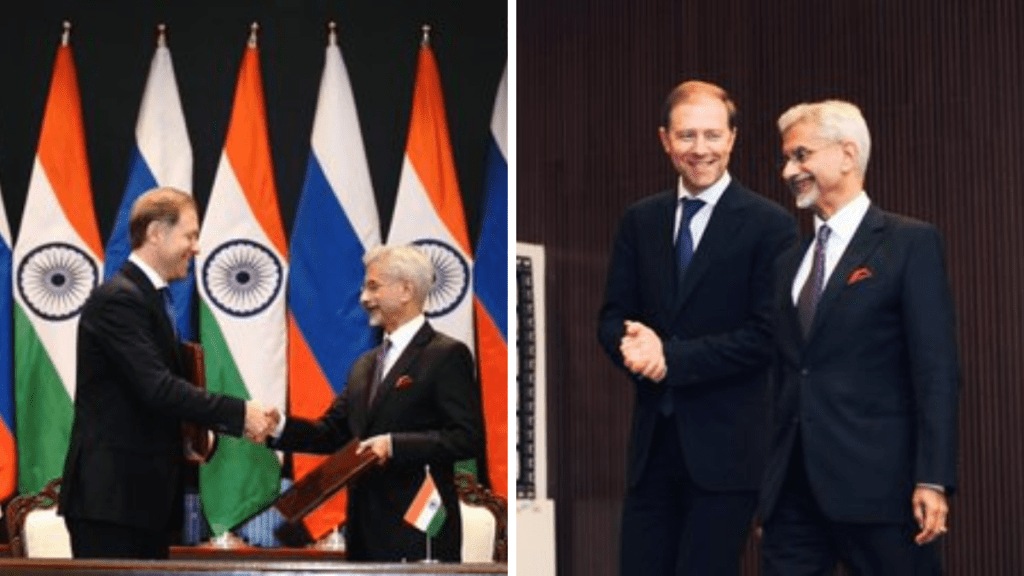India and Russia have set ambitious targets for their economic relationship, with a focus on achieving USD 100 billion in annual bilateral trade by 2030. According to External Affairs Minister S. Jaishankar, the two nations are confident that this goal will be achieved well ahead of schedule, underlining the growing significance of their ties on the global stage.
The growth trajectory of India-Russia trade has been impressive, particularly in the face of challenges related to logistics and payments. While progress has been made, there is still work to be done to address these issues. Jaishankar acknowledged the constraints but expressed optimism that with continued effort, the target of USD 100 billion would be realized sooner rather than later.
At the 25th session of the India-Russia Intergovernmental Commission on Trade, Economic, Scientific, Technical, and Cultural Cooperation (IRIGC-TEC), Jaishankar highlighted the complementary nature of the two economies. He said that the trust and confidence built over decades have contributed to the steady growth of bilateral trade, which has now reached approximately USD 66 billion. He stated, “Our economies are not only complementary in many respects but benefit from the trust and confidence built over many years.”
While the trade volume is substantial, Jaishankar pointed out that the trade balance needs to be more equitable, and this will require addressing current constraints and making trade facilitation easier. Both India and Russia are committed to undertaking greater efforts in this regard, including advancing negotiations on a Free Trade Agreement (FTA) between India and the Eurasian Economic Union (EEU). This FTA is expected to play a crucial role in expanding trade ties by simplifying trade procedures and removing barriers.
One of the key areas of cooperation between the two countries is in energy, with Russia becoming a major supplier of crude oil, coal, and fertilizers to India. Jaishankar also noted the growing significance of Russia’s uranium supply for India’s nuclear energy sector. At the same time, India’s pharmaceutical industry has emerged as a reliable source for Russia, supplying affordable medicines.
Jaishankar also touched on the potential for greater collaboration in emerging sectors. “We are exploring the mobility of talent, skills, and customizing them for the Russian market,” he said, underscoring the importance of human resource exchange in strengthening economic ties. In addition, connectivity initiatives such as the International North-South Transport Corridor, the Chennai-Vladivostok Corridor, and the Northern Sea Route are pivotal in facilitating trade and logistics between the two countries.
The growing economic cooperation between India and Russia is not limited to energy and pharmaceuticals. The diversification of trade, including the export of food products such as sunflower oil and soybean oil from Russia to India, marks an expanding range of bilateral exchanges. Jaishankar noted that India is committed to making it easier to do business, facilitating the growth of trade across various sectors.
Russia’s First Deputy Prime Minister, Denis Manturov, who led the Russian delegation at the IRIGC-TEC session, echoed Jaishankar’s sentiments about the rapid growth of bilateral trade. He highlighted the fivefold increase in trade turnover over the last five years and pointed out that India now ranks as Russia’s second-largest foreign economic partner. The positive dynamics have continued into 2024, with trade turnover rising by 9% in the first eight months of the year compared to 2023.
Manturov underlined that the diversification of trade between the two nations has been a key factor in this growth. He noted that while Russia continues to export energy sources and fertilizers to India, the two countries are also trading in a wider range of products, including industrial equipment, components, and pharmaceuticals. The diversification of the trade basket is a crucial aspect of their bilateral relationship, and both countries are committed to further broadening it.
The bilateral trade imbalance remains an area of focus for the two nations, and Manturov reiterated Russia’s commitment to addressing this through a comprehensive roadmap for cooperation until 2030. He also highlighted the importance of the Free Trade Agreement between the Eurasian Economic Union (EEU) and India, as well as the bilateral agreements on services and investments. These agreements are expected to meet the needs of both countries’ business communities and further facilitate trade expansion.
Jaishankar’s remarks about the larger resonance of India-Russia relations were particularly significant in the context of a rapidly changing global order. He stressed that the bilateral relationship has implications beyond the two countries themselves, given the increasingly multipolar world order. “As two major nations in an increasingly multipolar world, a more substantive relationship between us has a larger resonance,” Jaishankar stated, highlighting the global significance of their partnership.
The deepening economic ties between India and Russia also align with broader geopolitical objectives. Both nations share a commitment to a multipolar world and have maintained a stable and steady partnership over the past 75 years. While the traditional focus of their relationship has been in areas such as defence, nuclear cooperation, and space exploration, the current focus on economic ties signals the growing importance of trade and investment as pillars of their strategic relationship.

